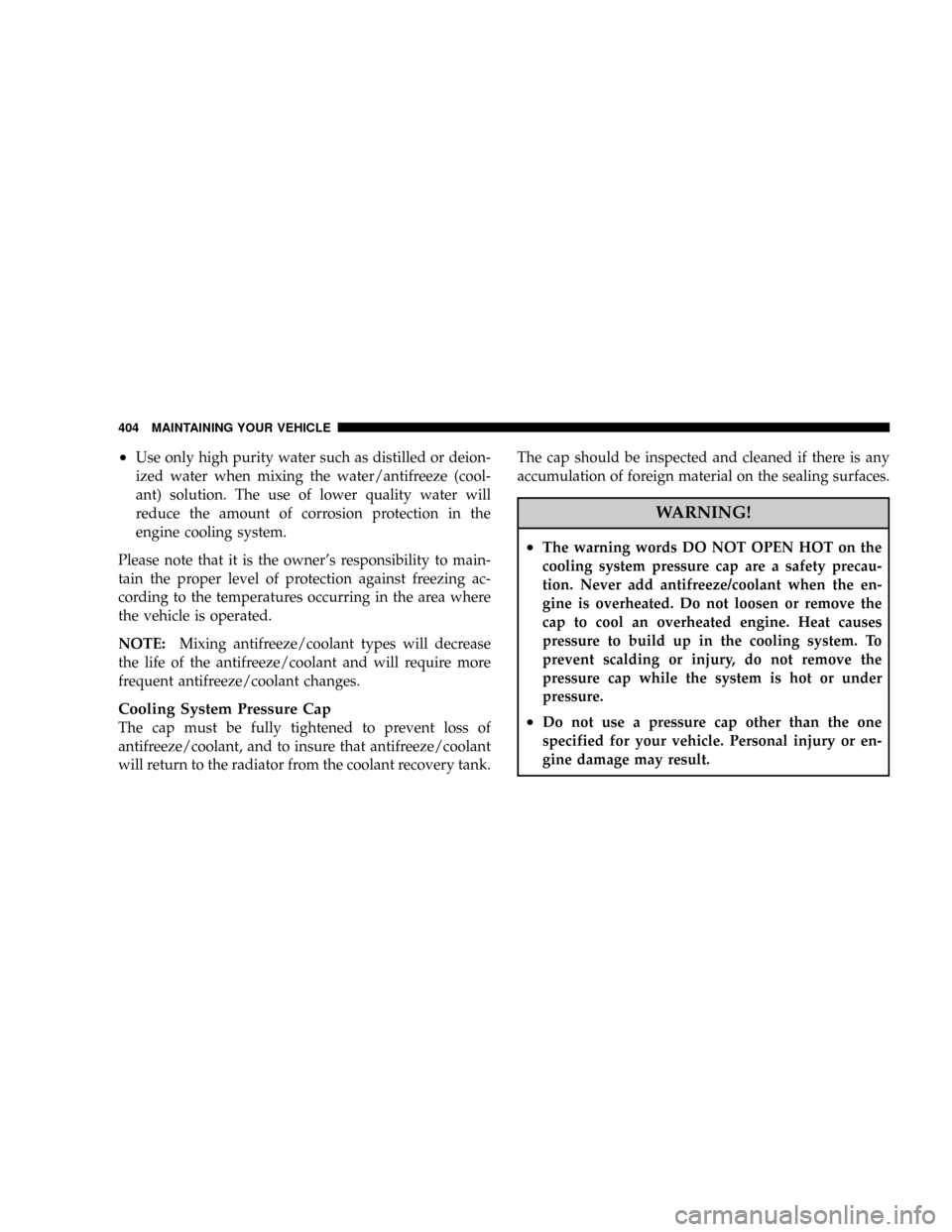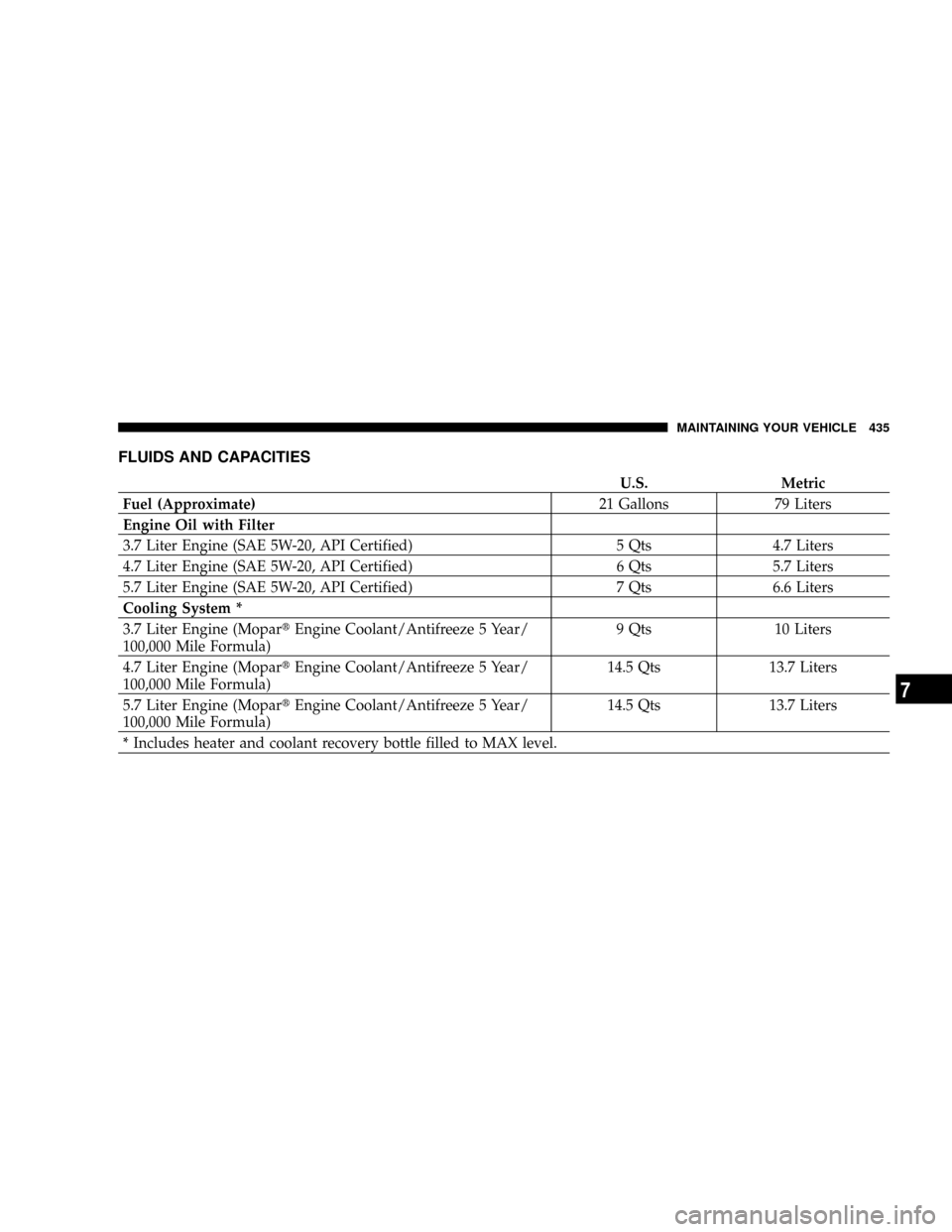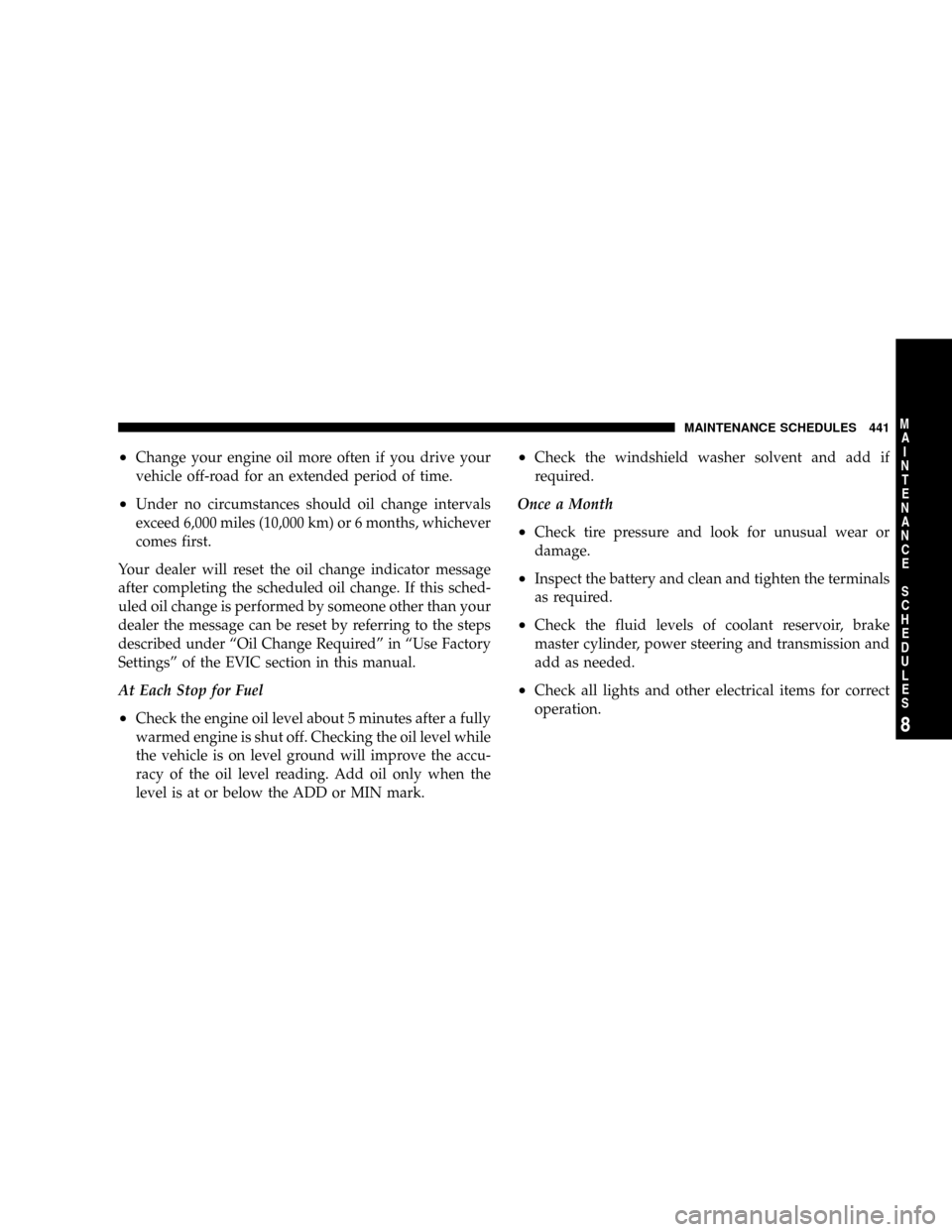coolant level JEEP COMMANDER 2008 1.G Owners Manual
[x] Cancel search | Manufacturer: JEEP, Model Year: 2008, Model line: COMMANDER, Model: JEEP COMMANDER 2008 1.GPages: 478, PDF Size: 6.97 MB
Page 198 of 478

²HOOD/GATE/DOOR OPEN (with graphic)
²HOOD/GATE/DOORS OPEN (with graphic)
²LIFTGLASS/DOOR OPEN (with graphic)
²LIFTGLASS/DOORS OPEN (with graphic)
²LIFTGLASS/HOOD OPEN (with graphic)
²WASHER FLUID LOW (with graphic)
²COOLANT LOW (with graphic)
²OIL CHANGE REQUIRED
²OIL CHANGE RESET
²CHECK GAUGES
²AUTO HIGH BEAMS ON
²AUTO HIGH BEAMS OFF
²PARK ASSIST DISABLED
²SERVICE SUSPENSION
²SERVICE PARK ASSIST SYSTEM
²TRANSMISSION OVER TEMP
²CHECK SHIFT PROCEDURE
²SERVICE 4WD SYSTEM
²4WD SYSTEM IN NEUTRAL
²LOW BRAKE FLUID LEVEL
²WARNING! LIMIT SPEED
²CHECK GASCAP
²ESP OFF
²IOD FUSE OUT
²HILL DESCENT CONTROL
²MEMORY #1 POSITIONS SET
198 UNDERSTANDING YOUR INSTRUMENT PANEL
Page 286 of 478

NOTE:To select the proper gear position for maximum
deceleration (engine braking), move the shift lever to the
left ªD(-)º and hold it there. The transmission will shift to
the range from which the vehicle can best be slowed
down.
Overdrive Operation
The automatic transmission includes an electronically
controlled Overdrive (5th gear for 3.7L engine, 4th and
5th gears for 4.7L and 5.7L engines). The transmission
will automatically shift from direct gear to Overdrive if
the following conditions are present:
²the transmission selector is in D (Drive);
²the engine coolant has reached normal operating tem-
perature;
²vehicle speed is above approximately 30 mph (48
km/h);
²the ªTOW/HAULº switch has not been activated;
²transmission has reached normal operating tempera-
ture.
NOTE:If the vehicle is started in extremely cold tem-
peratures, the transmission may not shift into Overdrive
and will automatically select the most desirable gear for
operation at this temperature. Normal operation will
resume when the transmission fluid temperature has
risen to a suitable level. Refer also to the Note under
torque converter clutch, later in this section.
During cold temperature operation you may notice de-
layed upshifts depending on engine and transmission
temperature. This feature improves the warm up time of
the engine and transmission.
If the transmission temperature gets extremely hot, the
transmission will automatically select the most desirable
gear for operation at this temperature. If the transmission
temperature becomes hot enough, the ªTRANSMISSION
286 STARTING AND OPERATING
Page 404 of 478

²Use only high purity water such as distilled or deion-
ized water when mixing the water/antifreeze (cool-
ant) solution. The use of lower quality water will
reduce the amount of corrosion protection in the
engine cooling system.
Please note that it is the owner's responsibility to main-
tain the proper level of protection against freezing ac-
cording to the temperatures occurring in the area where
the vehicle is operated.
NOTE:Mixing antifreeze/coolant types will decrease
the life of the antifreeze/coolant and will require more
frequent antifreeze/coolant changes.
Cooling System Pressure Cap
The cap must be fully tightened to prevent loss of
antifreeze/coolant, and to insure that antifreeze/coolant
will return to the radiator from the coolant recovery tank.The cap should be inspected and cleaned if there is any
accumulation of foreign material on the sealing surfaces.
WARNING!
²The warning words DO NOT OPEN HOT on the
cooling system pressure cap are a safety precau-
tion. Never add antifreeze/coolant when the en-
gine is overheated. Do not loosen or remove the
cap to cool an overheated engine. Heat causes
pressure to build up in the cooling system. To
prevent scalding or injury, do not remove the
pressure cap while the system is hot or under
pressure.
²Do not use a pressure cap other than the one
specified for your vehicle. Personal injury or en-
gine damage may result.
404 MAINTAINING YOUR VEHICLE
Page 405 of 478

Disposal of Used Engine Coolant
Used ethylene glycol-based antifreeze/coolant is a regu-
lated substance requiring proper disposal. Check with
your local authorities to determine the disposal rules for
your community. To prevent ingestion by animals and
children, do not store ethylene glycol-based antifreeze/
coolant in open containers or allow it to remain in
puddles on the ground. If ingested by a child, contact a
physician immediately. Clean up any ground spills im-
mediately.
Coolant Level
The coolant bottle provides a quick visual method for
determining that the antifreeze/coolant level is adequate.
With the engine idling, and warm to normal operating
temperature, the level of the antifreeze/coolant in the
bottle should be between the ranges indicated on the
bottle.The radiator normally remains completely full, so there is
not need to remove the radiator cap unless checking for
antifreeze/coolant freeze point or replacing antifreeze/
coolant. Advise your service attendant of this. As long as
the engine operating temperature is satisfactory, the
coolant bottle need only be checked once a month.
When additional antifreeze/coolant is needed to main-
tain the proper level, it should be added to the coolant
bottle. Do not overfill.
Points To Remember
NOTE:When the vehicle is stopped after a few miles
(kilometers) of operation, you may observe vapor coming
from the front of the engine compartment. This is nor-
mally a result of moisture from rain, snow, or high
humidity accumulating on the radiator and being vapor-
ized when the thermostat opens, allowing hot antifreeze/
coolant to enter the radiator.
MAINTAINING YOUR VEHICLE 405
7
Page 406 of 478

If an examination of your engine compartment shows no
evidence of radiator or hose leaks, the vehicle may be
safely driven. The vapor will soon dissipate.
²Do not overfill the coolant recovery bottle.
²Check antifreeze/coolant freeze point in the radiator
and in the coolant recovery bottle. If antifreeze/
coolant needs to be added, contents of coolant recov-
ery bottle must also be protected against freezing.
²If frequent antifreeze/coolant additions are required,
or if the level in the coolant recovery bottle does not
drop when the engine cools, the cooling system should
be pressure tested for leaks.
²Maintain antifreeze/coolant concentration at 50%
HOAT antifreeze/coolant (minimum) and distilled
water for proper corrosion protection of your engine
which contains aluminum components.
²Make sure that the radiator and coolant recovery
bottle hoses are not kinked or obstructed.
²Keep the front of the radiator clean. If your vehicle is
equipped with air conditioning, keep the front of the
condenser clean, also.
²Do not change the thermostat for summer or winter
operation. If replacement is ever necessary, install
ONLY the correct type thermostat. Other designs may
result in unsatisfactory cooling performance, poor gas
mileage, and increased emissions.
Hoses and Vacuum/Vapor Harnesses
Inspect surfaces of hoses and nylon tubing for evidence
of heat and mechanical damage. Hard or soft spots,
brittle rubber, cracking, tears, cuts, abrasions, and exces-
sive swelling indicate deterioration of the rubber.
406 MAINTAINING YOUR VEHICLE
Page 435 of 478

FLUIDS AND CAPACITIES
U.S. Metric
Fuel (Approximate)21 Gallons 79 Liters
Engine Oil with Filter
3.7 Liter Engine (SAE 5W-20, API Certified) 5 Qts 4.7 Liters
4.7 Liter Engine (SAE 5W-20, API Certified) 6 Qts 5.7 Liters
5.7 Liter Engine (SAE 5W-20, API Certified) 7 Qts 6.6 Liters
Cooling System *
3.7 Liter Engine (MopartEngine Coolant/Antifreeze 5 Year/
100,000 Mile Formula)9 Qts 10 Liters
4.7 Liter Engine (MopartEngine Coolant/Antifreeze 5 Year/
100,000 Mile Formula)14.5 Qts 13.7 Liters
5.7 Liter Engine (MopartEngine Coolant/Antifreeze 5 Year/
100,000 Mile Formula)14.5 Qts 13.7 Liters
* Includes heater and coolant recovery bottle filled to MAX level.
MAINTAINING YOUR VEHICLE 435
7
Page 441 of 478

²Change your engine oil more often if you drive your
vehicle off-road for an extended period of time.
²Under no circumstances should oil change intervals
exceed 6,000 miles (10,000 km) or 6 months, whichever
comes first.
Your dealer will reset the oil change indicator message
after completing the scheduled oil change. If this sched-
uled oil change is performed by someone other than your
dealer the message can be reset by referring to the steps
described under ªOil Change Requiredº in ªUse Factory
Settingsº of the EVIC section in this manual.
At Each Stop for Fuel
²Check the engine oil level about 5 minutes after a fully
warmed engine is shut off. Checking the oil level while
the vehicle is on level ground will improve the accu-
racy of the oil level reading. Add oil only when the
level is at or below the ADD or MIN mark.
²Check the windshield washer solvent and add if
required.
Once a Month
²Check tire pressure and look for unusual wear or
damage.
²Inspect the battery and clean and tighten the terminals
as required.
²Check the fluid levels of coolant reservoir, brake
master cylinder, power steering and transmission and
add as needed.
²Check all lights and other electrical items for correct
operation.
MAINTENANCE SCHEDULES 441
8
M
A
I
N
T
E
N
A
N
C
E
S
C
H
E
D
U
L
E
S
Page 459 of 478

Fluid and Filter Changes................. 411
Fluid Level Check................... 411,412
Fluid Type........................... 411
Special Additives...................... 414
Torque Converter...................... 288
Autostick............................. 285
Auxiliary Electrical Outlet (Power Outlet)...... 169
Auxiliary Power Outlet................... 169
Battery............................... 395
Emergency Starting..................... 374
Keyless Transmitter Replacement (RKE)....... 25
Saving Feature (Protection)............... 125
Belts, Drive............................ 392
Belts, Seat.............................. 39
Body Mechanism Lubrication............... 399
B-Pillar Location........................ 311
Brake Assist System...................... 141
Brake Control System, Electronic............. 139Brake System........................... 407
Anti-Lock (ABS)....................139,302
Hoses.............................. 408
Master Cylinder....................... 408
Parking............................. 300
Warning Light........................ 187
Brake/Transmission Interlock............... 283
Break-In Recommendations, New Vehicle........ 69
Bulb Replacement.....................427,428
Calibration, Compass..................... 204
Camera, Rear........................... 157
Capacities, Fluid........................ 435
Caps, Filler
Fuel................................ 341
Radiator (Coolant Pressure)............... 404
Car Washes............................ 415
Carbon Monoxide Warning...............70,337
Cargo Area Features...................... 174
INDEX 459
10
Page 460 of 478

Cargo Compartment...................... 174
Luggage Carrier....................... 177
Cargo Load Floor........................ 174
Catalytic Converter...................... 393
CD (Compact Disc) Player................. 239
Cellular Phone.......................... 82
Center High Mounted Stop Light............ 434
Certification Label....................... 344
Chains, Tire............................ 322
Changing A Flat Tire..................... 368
Chart, Tire Sizing........................ 308
Checks, Safety.........................71,72
Child Restraint....................60,61,65,67
Child Restraint Tether Anchors.............64,65
Child Safety Locks........................ 30
Climate Control......................... 257
Clock........................213,229,240,243
Cold Weather Operation................... 278
Command View Skylights.................. 168Compact Disc (CD) Maintenance............. 256
Compass.............................. 203
Compass Calibration..................... 204
Compass Variance....................... 204
Computer, Trip/Travel.................... 200
Connector
UCI ................................ 244
Universal Consumer Interface (UCI)......... 244
Console, Overhead....................... 158
Contract, Service........................ 450
Converter, Catalytic...................... 393
Cooling System......................... 401
Adding Coolant (Antifreeze).............. 403
Coolant Capacity...................... 435
Coolant Level......................... 405
Disposal of Used Coolant................ 405
Drain, Flush, and Refill.................. 402
Inspection........................401,405
Points to Remember.................... 405
460 INDEX